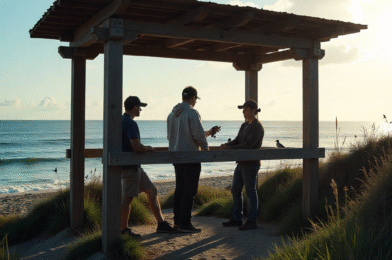You live in a world of constant notifications, endless to-do lists, and the relentless pressure to be more productive. You are connected to thousands of people through a screen, yet you may feel a growing sense of disconnection from the things that truly matter. There is a quiet longing in your heart for something real, something tangible, something slower.
What if you could answer that longing? What if you could step off the fast-moving train of modern life and onto an unhurried path? This is the invitation of volunteering in the countryside. It’s a deliberate choice to trade the noise of the city for the sounds of nature, to exchange complexity for simplicity, and to discover the profound strength and beauty of rural communities.
This is not about a lack of amenities; it’s about an abundance of what is essential. It’s a world where success is measured by a healthy harvest, where wealth is found in strong relationships, and where the most valuable currency is a helping hand offered to a neighbor.
This guide is for you if you are seeking a journey that nourishes the soul. It is for you if you believe the strongest bonds are forged not in grand gestures, but in shared work, quiet conversations, and meals enjoyed together at the end of a long day. We will explore the deep, transformative power of this unhurried path and visit several countryside communities around the globe where you can find purpose, connection, and a home away from home.
The Soul of the Countryside: Why This Experience Changes You
Volunteering in a rural community is more than just a change of scenery; it’s a fundamental shift in your way of being. The environment itself becomes your teacher, offering lessons that will stay with you long after you leave.
The Rhythm of the Seasons
In the countryside, life is not dictated by the 9-to-5 grind. It moves to a more ancient and powerful clock: the rising and setting of the sun, the turning of the seasons, and the needs of the land. You will learn the patience of waiting for seeds to sprout, the satisfaction of the harvest after months of work, and the wisdom of resting during the quiet months of winter. This rhythm teaches you to be more present, to appreciate the process as much as the outcome, and to find peace in a life that is cyclical, not linear.
The Power of Interdependence
In a world that prizes radical independence, the countryside reminds you of the strength found in mutual reliance. When a storm damages a neighbor’s fence, the community shows up to help rebuild it. When it’s time for the harvest, many hands make for light work. You will quickly find your place in this web of reciprocity. Your contribution, no matter how small, becomes part of the town’s collective well-being. This experience can heal the modern ailment of isolation, reminding you that we are truly stronger together.
Simplicity as a Strength
When you live in a place with fewer material distractions, you are forced to confront the difference between what you want and what you truly need. You discover that happiness doesn’t come from consumption, but from connection—to people, to nature, and to meaningful work. Stripping away the non-essentials often leads to a richer, more focused inner life and a deeper appreciation for the simple gifts of a hot meal, a clear night sky, and a heartfelt conversation.
Building Bonds Over the Fence Post
In the countryside, relationships aren’t rushed. They are built slowly, organically, and authentically. They are forged in the shared silence of an early morning, in the easy banter while working in a field, and in the stories swapped over a cup of tea. You won’t just know your project coordinator; you’ll know their children, their parents, and their cousin who lives down the road. This is the deep, lasting connection that your soul has been longing for.
Global Countrysides Waiting to Welcome You
From the sun-drenched hills of Italy to the misty mountains of Japan, opportunities to embrace this simpler way of life abound. Here are five countryside destinations where you can find your place.
1. The Rolling Hills of Tuscany, Italy
This is the classic, romantic vision of the countryside. A landscape of rolling hills, silver-leafed olive groves, and winding roads lined with cypress trees. Life in rural Tuscany is a celebration of family, food, and the fruits of the land.
- The Countryside Life: The pace is slow and sensual. Days are structured around the work of the farm and the sacred ritual of the family meal.
- Your Role in the Community: You will likely find yourself on an “agriturismo,” a small, family-run farm that often hosts guests. Your work will be seasonal and deeply connected to the land. You could be helping with the grape harvest in the fall, the olive harvest in the winter, or tending to the vegetable garden in the summer. Learning to make pasta from scratch or preserve tomatoes might be part of your duties.
- Finding Your Place: You will be welcomed not as a worker, but as part of the “famiglia.” Your bond will be forged over the long, loud, and joyful dinner table, sharing wine made from the very grapes you helped pick.
2. The Japanese Alps (Nagano Prefecture)
Venture away from the neon glow of Tokyo and you’ll discover a very different Japan. In the mountains of prefectures like Nagano, you’ll find ancient farmhouses with thatched roofs, terraced rice paddies climbing up the hillsides, and a culture of quiet dignity and profound respect for nature.
- The Countryside Life: Life here is orderly, peaceful, and deeply in tune with the seasons. The community is often made up of elderly residents who are the keepers of traditional farming methods.
- Your Role in the Community: Many villages face depopulation, and your presence can bring youthful energy and vital help. You might assist with planting or harvesting rice, maintaining traditional farmhouses (“minka”), working on a small organic wasabi or soba farm, or simply providing companionship and assistance to elderly residents.
- Finding Your Place: The bond here is formed through quiet, shared work and mutual respect. It is in the unspoken understanding of a task done well, the shared satisfaction of a day’s labor, and the gentle smile of an elder as you learn a new skill.
3. A Rural Village in Ghana
In the lush countryside of Ghana, you will find that the community is everything. Life is lived outdoors, and the line between family and neighbor is beautifully blurred. The sound of drumming and laughter is the constant soundtrack to daily life.
- The Countryside Life: Vibrant, communal, and deeply relational. Your presence will be a cause for celebration, and you will be welcomed with open arms into the heart of the village.
- Your Role in the Community: You will be supporting community-led development projects. This could involve assisting a teacher in a small, under-resourced school, helping with the construction of a new library or health clinic, or working alongside local farmers on a community agricultural project.
- Finding Your Place: You will be “adopted” by a host family and quickly become a brother, sister, son, or daughter. The bond is formed through shared meals of fufu and groundnut soup, through learning to dance to the beat of the drum, and through the dozens of children who will adopt you as their favorite new playmate.
4. The Coffee Highlands of Colombia
After decades of conflict, the Colombian countryside is experiencing a renaissance of peace and hope. In the lush, green mountains of the “Eje Cafetero” (Coffee Axis), you can partner with small, family-run coffee farms (“fincas”) that are the backbone of the local economy.
- The Countryside Life: The air is fresh and filled with the smell of coffee blossoms. The days start early with the crow of the rooster and a cup of the world’s best coffee.
- Your Role in the Community: You will become part of the coffee-making process from bean to cup. Depending on the season, you could be picking the bright red coffee cherries, helping with the washing and drying process, or learning about sustainable, shade-grown farming practices that protect the local ecosystem.
- Finding Your Place: The bond is formed over that first cup of “tinto” in the morning, shared with the farmer as you look out over the coffee plants. It’s in the shared pride of producing a world-class product through hard, honest work.
Embracing the Unhurried Path: Tips for Success
- Adjust Your Expectations: Your goal is not to “save” the community or implement massive change. Your goal is to learn, support, and participate. The impact is in the relationship, not necessarily in a finished project.
- Bring a Skill to Share (and a Desire to Learn): Maybe you can help a farmer set up a simple website, or maybe your only skill is a strong back and a willingness to learn how to use a hoe. Both are incredibly valuable when offered with humility.
- Leave Your Ego at Home: You are entering a world that has its own wisdom, cultivated over centuries. Listen to the stories, respect the local leadership, and understand that you are a guest in their home.
- Master the Art of “Doing Nothing”: In our culture, we feel pressure to always be busy. In the countryside, some of the most important moments happen when you are simply sitting, observing, and being present. Get comfortable with silence. It’s where trust is built.
In a world that screams for you to go faster, do more, and be bigger, the choice to volunteer in the countryside is a quiet act of rebellion. It is a declaration that you value depth over distance, connection over consumption, and people over productivity. On this unhurried path, you will discover that in the act of giving your time to a small community, you receive the priceless gift of belonging.
What part of “simple living” or “strong bonds” calls to you the most right now? Share your thoughts on why you’re drawn to the countryside in the comments.





